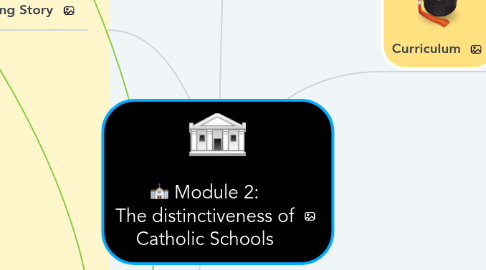
1. The Founding Story
1.1. The beginning: The set up of Catholic Schools (1843-1867)
1.1.1. Most started from home
1.1.2. Teachers:
1.1.2.1. Priests and sister of Mercy were teachers.
1.1.3. Students: Wealthy, poor, orphan, infants.
1.1.3.1. 30 Boys attended school
1.1.3.2. Sisters established first school for girls (primary level). 1 girl attended on first day. By September, 100 enrollments mostly from protestant families.
1.1.3.3. day school for young ladies (Mercedes College), opened to girls of all faith
1.1.4. Funds:
1.1.4.1. Rome and Europe
1.1.4.2. 27 Missionarys
1.1.4.3. Wages paid by bishops and parents
1.1.4.4. Fundraising, fates etc
1.2. Expansion (1868-1894)
1.2.1. Teachers : majority of lay teachers were recruited for teaching positions with some sisters remaining as teachers.
1.2.2. Students:
1.2.2.1. Separate girls and boys schooling
1.2.2.2. Compulsory for ages 6-13yrs
1.2.3. Funds:
1.2.3.1. All schools where funded by government
1.2.3.2. gold rush
1.3. Struggle (1895- 1971)
1.3.1. Teachers:
1.3.1.1. the religious order took over teaching (brothers and sisters).
1.3.1.2. 200+ with a small percent trained
1.3.1.3. A large number where the young age of 16/17 year olds
1.3.2. Students:
1.3.2.1. Compulsory schooling
1.3.2.2. Crowed classrooms 100 per room
1.3.3. Funds
1.3.3.1. Free and Compulsory
1.3.3.2. All schools fundraised
1.3.3.3. Accomodation, board and food where supplied to all teachers
1.4. New Direction (1972 +
1.4.1. Teachers:
1.4.1.1. All need to be qualified
1.4.2. Students
1.4.2.1. Catholic schools now have funds to provide programs for children from Aboriginal and migrant families, children with special needs, and technical and adult education.
1.4.2.2. Single sexed, Aboriginal, 1/4 students Non Catholic, Variety of Students from all social classes
1.4.3. Funds
1.4.3.1. Based on needs of school
2. Theme/ Message that the schools where trying to portray
2.1. A place for all
2.2. Teaching the whole person
3. How has it changed ?
3.1. Earlier
3.1.1. Main socialising agency
3.1.2. Children sent out of fear
3.1.3. School taught by brothers and sisters
3.2. Today
3.2.1. Catholic Education is about evangelisation
3.2.2. To learn about the scriptures and to values them
3.2.3. handing on tradition they can part in
4. Mandate Letter
4.1. Core Beliefs and Values
4.2. Why Catholic schools
4.2.1. Connects Catholic schools to the life of the church and belief in the Christ
4.2.2. outlines all the roles in Catholics education
4.2.3. to evangelise
4.3. Mandate Letter
4.3.1. Presence of God
4.3.1.1. All discussions must begin with God
4.3.1.2. Evangelise:
4.3.1.2.1. To convert or seek to covert
4.3.1.2.2. To spread the good news
4.3.2. Witness of the Catholic school
4.3.2.1. The people of the school and community
4.3.3. Curriculum in the Catholic school
4.3.4. The Catholic school community
4.3.4.1. "It takes a whole village to raise a child"
4.3.4.1.1. Family
4.3.4.1.2. Local Church
4.3.4.1.3. School
5. Curriculum
5.1. Curriculum in Catholic School
5.1.1. Every educational activity in a school is part of the curriculum
5.1.2. Evangelisation through word.
5.1.2.1. Using words to proclaim the goof news in the same ways Jesus did
5.1.2.2. Religious Education
5.1.2.3. Gospels
5.1.3. Mandate
5.1.3.1. Know and Understand (Head)
5.1.3.2. Value (Heart)
5.1.3.3. be able (hands)
5.2. Mandate
5.2.1. For a school to be Catholic, it must first be a good school. Otherwise it will be unable to fulfil its mission.(35)
5.2.2. Learning to integrate faith and culture will help students develop a Gospel vision of Australian society. It will also help them to work out practical ways of promoting that vision to others. (21)
5.2.3. Teaching students to integrate faith into daily life means helping them above all to understand what is involved in Christian discipleship – making a ‘total commitment of one’s whole being to the Person of Christ’.46
5.2.4. In schools, there are teachers, too, who integrate Gospel values into the other curriculum. (Mandate, para 25.)
5.3. Catholic Education
5.3.1. Focuses on students and all their experiences as valuable to their education
5.3.1.1. Gospels values are integrated into all outcomes and content areas
5.3.1.2. All learning areas need to contribute to evangelisation
5.3.2. Religious dimension
5.3.2.1. Helps students create and see a relationship between faith and culture
5.3.2.2. Mandate para 16/18.
5.3.2.3. establishing their identity as individuals and members of the community
5.3.2.3.1. guide, nurture, postive teachings, belonging, meaningful and purpose.
5.3.3. Distinctiveness
5.3.3.1. Caters for all
5.3.3.1.1. Development of the whole person
5.4. ACARA
5.4.1. Focuses on the content and the quality if the teachers
